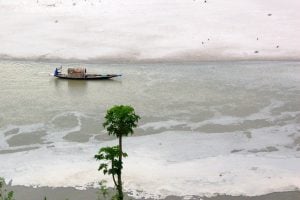In 2010 an organisation I was working with held a conference on water issues. The rhetoric on the Indus was being tapped by militant organisations, and it was in the interest of both India and Pakistan to encourage some dialogue on the issues involved before it became unmanageable. One scene from that conference stands out in my mind. One of our Pakistani guests – a water expert himself – said, “You have no idea what we are struggling with. Do you realise that in my city (I forget now whether he was referring to Karachi or Lahore) we have water for only two hours a day?”
One of the Indians at the table coughed, and said quietly, “That is about how much water we get in Delhi as well.”
That conversation was an icebreaker. It suddenly reconceptualised the discussions we were having at a very human level. It also brought home to all of us how little we knew about the challenges being faced by people living in the same region.
Too often talk on water between Indians and Pakistanis is reduced to discussing the Indus Waters Treaty of 1960, how it works, and how it fails. It is easy to understand why this is the case because the vast majority of fresh water in Pakistan is supplied by the rivers of the Indus Basin. Since these rivers flow through the Indian states of Jammu & Kashmir, Himachal Pradesh and Punjab before arriving in Pakistan, any drop in water levels, and consequent water shortage is easily seen as an India-Pakistan issue.
The reality is far more complex. Rivers are too often seen as mere carriers of water, glorified canals that transport water from one place to another, instead of being seeing as large, complex ecosystems that can be affected in a multiplicity of ways. Part of the problem is the Treaty itself. By its very nature it is a creation of its time, when engineering solutions were seen as the acme of achievement. More importantly, as those who have studied the history of the Treaty know, it is not the ideal that was imagined when the negotiations began.

In his book, Indus Divided: India, Pakistan and the River Basin Dispute, published in 2017, Daniel Haines does a great job in situating the creation of the treaty in the tense atmosphere of post-Independence and post-Partition days. And yet, despite the first war between the two countries, this was also the time when the Nerhu-Liaquat Pact was worked out, when the two countries did try to find some modus vivendi vis-à-vis each other. People on both sides of the border forget that it was only after the 1965 war that the borders hardened, and visas became requirements, unlike before where travel could be done on domicile documents (as was attempted in allowing Cross-Line of Control travel after 2005 in Kashmir.) Nevertheless the times were not suitable to push through a treaty that would allow joint maintenance of the basin, or at least the part of the basin in the two countries. Therefore the Treaty remains a treaty of divorce, with one set of rivers managed by India, and the other – except for certain specific and limited usage strictly defined in the Treaty – for the use of Pakistan.
Nor is the Treaty perfect. No treaty ever is. It is the nature of such agreements to leave all sides somewhat unhappy, since that is still better than no treaty, great unhappiness, and no mechanism to resolve the issues that may crop up. Within these broad parameters the Treaty works, because it continues to serve the self-interest of both countries within very strict bounds.
The problems arise from both external and internal factors. The external factors are, in a sense, easy to list. The first, and foremost, of these is the lack of China and Afghanistan as signatories to the Treaty despite having part of the Indus Basin in their territory. This is a problem more for Pakistan than for India, as the large part of the catchment area is not in China. Furthermore Afghanistan is upstream only to Pakistan, and thus India is not affected by its water usage directly – unlike Pakistan. Nevertheless it makes the holistic treatment of the Indus Basin as a single unit impossible from within the Treaty. The Treaty has the space to try and build on this, but it is unlikely that the current geopolitical realities would be conducive to create such an opportunity.
The second external factor that affects the Indus Basin is also beyond the control of India and Pakistan, and that is climate change. The key outcomes of climate change: disruption of weather patterns leading to more frequent and more intense floods and droughts, as well as higher than average temperatures, are going to be with us no matter what we do. Unfortunately, given how massive an impact it is having in the Himalayan region, there are very few organisations – with the exception of the International Centre for Integrated Mountain Development (ICIMOD) and the International Water Management Institute (IWMI) – that are focussed on what is happening. This means that as the Himalayas as a whole change in character, affecting the largest concentration of ice and snow on the planet after the North and South Poles, the countries in the region are only focussed on what is happening within their borders, and unable to accurately predict changes, or reasonably deal with them.
In 2014 a massive downpour in the Indian state of Jammu & Kashmir led to huge losses and killed hundreds. Inevitably these rushing waters, and massive downpour, impacted Pakistan too, causing havoc and also killing hundreds. No dynamic flood control mechanism exists across these territories, costing both countries massive damage in both lives and wealth, often impacting the most marginalised communities the most. While the countries cannot control the outcome of climate change, they do have the power to cooperate on dealing with the impacts. But once again, political realities seem to outweigh the practical consequences of non-cooperation.
Focussing on external issues, though, may obscure what is closer to the ground and easier to fix. One of the main challenges for water usage across South Asia, and especially in India and Pakistan, is the water intense form of agriculture. In both these countries most of the water, around 80%, is devoted to growing crops. More importantly much of this water is simply wasted. Both of these countries use a form of rice cultivation in which the crop is grown in standing water, and much of this water simply evaporates. More problematically, large amounts of water are transported through leaky canal structures over long distances, evaporating on the way, and ending up diverting far more water than is actually needed to grow the crops.
Part of the problem remains unequal access to water, and so Sindh – the province in Pakistan that has the best and oldest water distribution system – ironically has some of the worst human development parameters in the country. Similarly, across various states of India, the provenance of free electricity to farmers has driven a massive increase in the installation of water pumps that pull up groundwater to irrigate the fields. With the irregular rainfall brought on by climate change, and complicated access to water through canals, farmers are drawing out as much water as they can, often far beyond the natural capacity for this groundwater to recharge. As the water levels plummet, not only do the poorer farmers – who cannot afford to dig deeper – suffer, but the minerals in the water, including dangerous ones like arsenic, become concentrated.
To add to these water problems, the greed for land – whether as farmland or as living space – means that the natural and artificial water bodies that would sustain the water levels, such as lakes, marshlands, and small ponds, have been almost wiped out. This makes it harder for water to filter through into the ground below to recharge aquifers, and during droughts, it makes it harder for marginal farmers to survive. In cities, though, it has another drastic effect as lake and riverbeds are built over. One of the lessons of the tragic 2014 floods was that they were supercharged not just by excessive rain over a very short period, but that mismanaged urbanisation in Srinagar meant that there was nowhere for the water to flow, except into inhabited areas – with catastrophic effects.
Lastly, but certainly not the least important, is the issue of solid waste management, primarily non-biodegradable plastics. In a series of features we did documenting the cities in the Himalayan region – including Peshawar, Karachi, Srinagar, Kathmandu, Dhaka, Thimphu, and the Qinghai plateau in China’s Tibetan region – it was striking how common the issues were. Across the Himalayan region – with Bhutan being a little of an exception – plastic was everywhere. Much of it was clogging up drains. There were few examples of sewage plants working the way they had been envisaged. It is little surprise, then, that the most polluted rivers are in Asia, and that these rivers are dying across the region.

One of the successes that Imran Khan, as the new Prime Minister of Pakistan, can claim from his party’s leadership in Khyber Pakhtunkhwa is the Billion Tree Tsunami, in which his party the PTI made reforestation a priority. Tree cover in a mountainous region helps manage temperatures, prevent landslides, and retain topsoil, which, in turn, helps the soil retain moisture and help recharge water tables. In India, poor farmers dealing with climate change became part of a 100 village project in 2010, shifting beyond mono-cropping, learning to deal with vagaries of the weather, and making a profit.
The problem with discussing water on an inter-governmental level is that the issues discussed sometimes lose sight of the lives of the common citizens of both countries who stand to lose, or benefit. Rightly or wrongly, the Indus Waters Treaty will dominate the discussion on water when the countries discuss issues at the highest levels, but it is at best a limited lens to deal with the massive challenges that both countries face. Given that so much of our agricultural, political and social systems are alike, it would make sense to broaden the conversation, to try and understand what is happening across the whole basin, both the good and the bad. And, as in so many things, the people are ahead of the leaders, as they read the news, and pick up innovations that are taking place in towns they have only heard of.
If only the governments helped take these discussions forward, made it easier for people from both countries to meet, exchange ideas, and innovate together, imagine how far we might go.
This article was originally published in Global Village Space, and has been republished with permission.
![<p>The Indus at the site of the proposed Diamer-Basha dam [image by: Water and Power Development Authority, Pakistan]</p>](https://dialogue.earth/content/uploads/2017/05/Indus_Diamer_Basha_Dam_Site_Image_WAPDA-300x169.jpg)

![In a village on the edge of the Sundarbans and facing the Bay of Bengal, Jasimuddin Sarkar in front of his farm that now grows nothing, thanks to sea level rise, and his house that gets flooded with dirty saline water every third or fourth day [image by: Joydeep Gupta]](https://dialogue.earth/content/uploads/2018/10/Farmer_Jasimuddin_Sarkar_Baliara_Mousuni_Joydeep-e1515995272635-300x200.jpg)


![Silt farmers growing vegetables on sand deposited by the Gandak river [image by: Nidhi Jamwal]](https://dialogue.earth/content/uploads/2018/10/IMG_3663-300x225.jpg)



